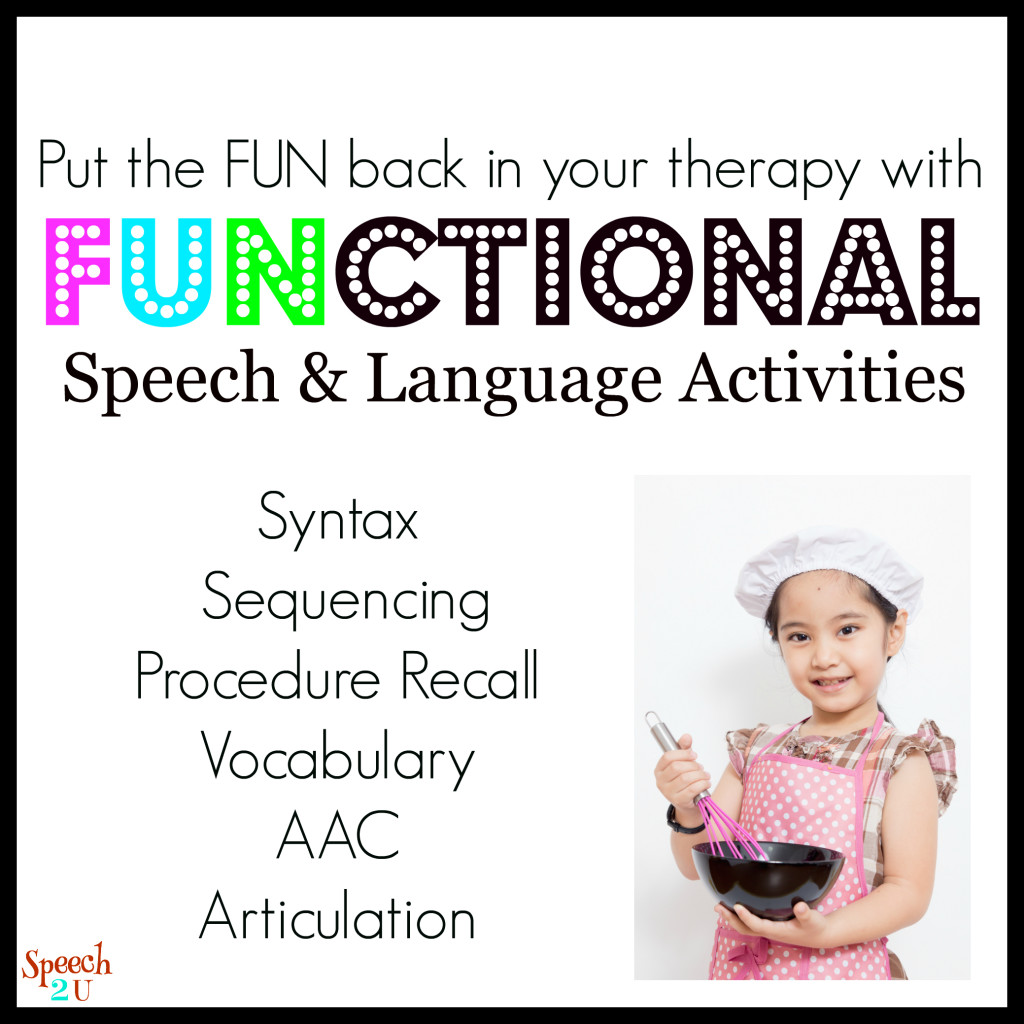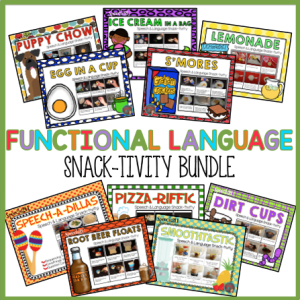Have you ever wanted to do more functional language activities with your students or clients? When you take time to figure out what your language targets are-snacks can be very effective in facilitating carryover of skills learned in your speech room. Make sure to check with families first on any food allergies or have them fill out a consent form if needed.
I use snack activities with a variety of my clients. I find that I can really engage my clients who have Down Syndrome or other developmental disabilities using these activities.
Functional Language Activity Targets
There are a lot of things that we can work on within a functional snack activities including:
Sequencing
I use full color photos for most of my snack activities. We review them prior to starting the activity and talk about what steps we will need to complete. As we are completing the snack, I use the pictures to help keep them on track. Afterwards, I have them sort the pictures based on what happened first and last.
Narrative Development/procedural retell
Many of my clients struggle with how to retell a procedure-or can’t even tell me a simple story about something they did at home. Others have more difficulty sequencing their thoughts-they may start in the middle of a story and it is difficult to follow them. Check out my posts on narrative development to learn more. I like to have them do a simple first, then, last procedural retell. Another fun way to work on sequencing is to have them do a mini-review (Ex. “Today I made ***** in speech. It tasted sweet/sour/good/bad. I would/wouldn’t make it again.)
Articulation
I usually start by looking at the recipe list and pick out all of the words that have the target sounds in them. I may have them say each target word 5-10 times before each step to make sure that we are maximizing our therapy time. At the end of the session or at the next session, I have them retell the procedure to me so that I can assess how they are using their targeted words and sounds within connected speech.
Following Directions
Snacks are an easy way to work on following directions. Again, I think it is helpful to look at the recipe and create your list of directions before the activity. For example, if I am working on temporal concepts, I could give a direction like, “Before you put the cheese on, butter the bread.”
Comprehension/WH questions
Once we have finished the activity, I can work on WH questions and comprehension. I may work on questions specifically related to the activity-or I may work on more factual questions. Some examples:
- What did we do first?
- Who completed (a certain step)?
- Where could you buy these ingredients?
- Why did we need an oven mitt to take the pan out of the oven?
- When did we melt the chocolate?
Syntax
If we are working on syntax, I could have them try to combine sentences using conjunctions related to the directions OR I could come up with a list of verbs related to the activity and use those to work on verb tense forms.
Core Words/AAC
I use core words when I am starting out with any client who needs to develop language. So rather than focusing on the nouns within an activity, I am focusing a lot of verbs-and abstract verbs that we tend to use a lot. We talk about getting the ingredients, putting things in or on top, turning things on/off/up/down or around. We can eat our snack, make some more, and decide if we like or don’t like it. Snack activities are pretty motivating for most of my clients-and if we are doing different snacks, I am able to teach core word vocabulary across a couple of different settings to improve generalization.
Executive Functioning
Snacks or project based activities are great for working on executive functioning and planning. We can review the recipe and make a plan for what we will need and what we already have. We can make shopping lists and decide where we will get the supplies.
Getting Started
Once you have found out about any potential food allergies and gotten permission from the parents, it’s time to get started. I like using snack activities that have just a few steps so that I can focus on my language therapy vs. getting caught up in making sure that the snack is completed correctly. The website, “Making Learning Fun” has some great 3-4 step visual recipes you can use.
Microwave popcorn or making toast are two other quick activities that you could try. I write out the directions before we start the task so I can determine my therapy targets-if I can’t find any-then I switch to a different activity. I like to take photos of each step prior to the session as well so that we can work on sequencing and procedure retell. You could also have your clients draw pictures of the steps after the activity.
If you are interested in trying out some activities-but don’t have the time to set everything up, you can always check out one of my Snack-tivities on TPT. I just finished adding core and fringe vocabulary pages to each product.
Do you have any “go to” activities for your speech room? I’d love to hear about them! If you thought this post was helpful or contained good information, I’d be excited if you would take the time to share with your friends and colleagues using the social media buttons below.




